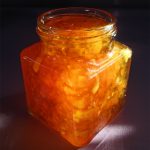 The jam known as marmalade in English is known as marmelada in Spanish, marmelade in French, marmellata in Italian, marmelad in Swedish, and marmelade in German, Dutch, and Danish. These words all derive from the Portuguese name for the jam, marmelada, which took its name from the Portuguese word marmelo, meaning quince, the fruit originally used in marmalade. This Portuguese fruit-name had earlier been derived from the Latin word melimelum, literally meaning honey apple, a name the ancient Romans borrowed from the ancient Greeks, who had bestowed it upon the fruit produced by grafting apple and quince. Another popular, but mistaken, explanation of the word’s origin is that it derives from Marie malade, meaning sick Mary. According to this folk etymology, Mary Queen of Scots could only eat one thing when feeling under the weather: a conserve made of oranges, which was subsequently named after her. Unfortunately for this folk etymology, however, the word marmalade appeared in English in 1524, eighteen years before Mary was born.
The jam known as marmalade in English is known as marmelada in Spanish, marmelade in French, marmellata in Italian, marmelad in Swedish, and marmelade in German, Dutch, and Danish. These words all derive from the Portuguese name for the jam, marmelada, which took its name from the Portuguese word marmelo, meaning quince, the fruit originally used in marmalade. This Portuguese fruit-name had earlier been derived from the Latin word melimelum, literally meaning honey apple, a name the ancient Romans borrowed from the ancient Greeks, who had bestowed it upon the fruit produced by grafting apple and quince. Another popular, but mistaken, explanation of the word’s origin is that it derives from Marie malade, meaning sick Mary. According to this folk etymology, Mary Queen of Scots could only eat one thing when feeling under the weather: a conserve made of oranges, which was subsequently named after her. Unfortunately for this folk etymology, however, the word marmalade appeared in English in 1524, eighteen years before Mary was born.
A preparation made by boiling chopped fruit and sugar until it achieves a dense and translucent, jelly-like texture. This delicacy is typically crafted from citrus fruits, and its taste profile generally leans towards the tart side. The term itself originates from “marmelo,” the Portuguese word for quince, which was the primary ingredient utilized in creating the first marmalade.
Introducing a luscious and indulgent preserve that has a rich history—marmalade. Traditionally crafted from unpeeled bitter oranges, the name itself finds its origins in the Portuguese word “marmalada,” which can be traced back to the Latin word for quince. Initially, this preserve was made from quinces, but over time, it has become synonymous with a delightful creation made from Seville oranges in England. This beloved breakfast treat pairs exquisitely with toast and butter, forming an iconic morning combination. It is worth noting that marmalade can also be made from other citrus fruits such as lemons, limes, and grapefruits, further expanding its flavor variations. In France, however, the term “marmalade” refers to a thick puree obtained by gently stewing fruits until they reach a considerably reduced consistency. This technique can be applied to a wide array of fruits, resulting in delightful fruit compotes. Embrace the enchantment of marmalade, whether it be the traditional Seville orange variety or the diverse fruit purees that grace the French culinary landscape.
